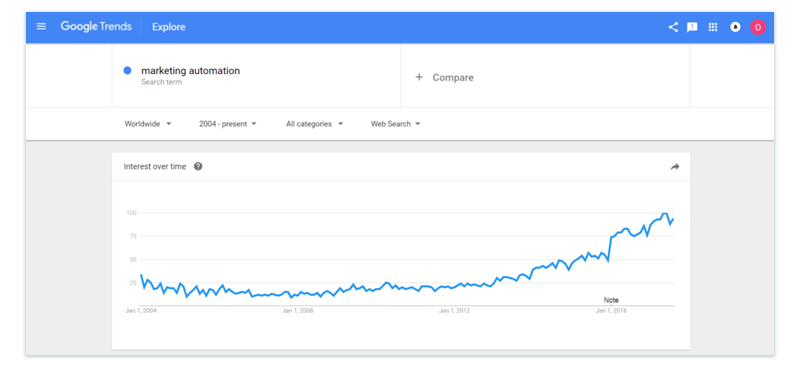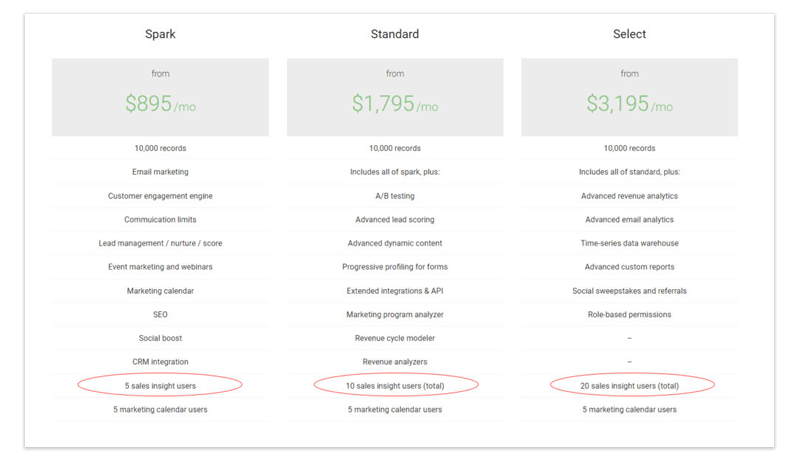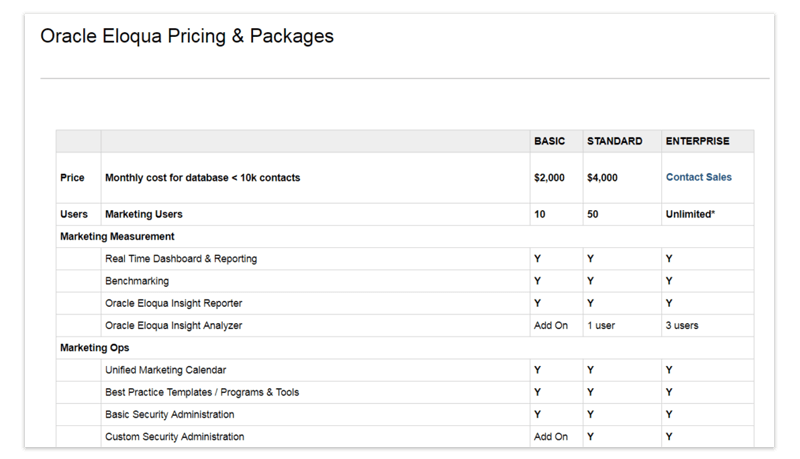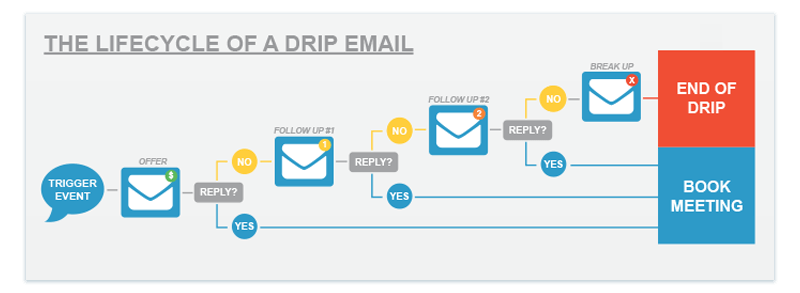
An Introductory Guide to Marketing Automation
Marketing has a come a long way from the days of mailbox stuffing coupons and various other direct mailers, that eventually ended up as cage liners for said customer’s family pets. In the age of self-driving cars and the Internet of Things, there are much more effective ways to reach new customers and nurture leads. If you guessed I was eluding to marketing automation platforms, then you guessed right.
According to Google Trends, searches for marketing automation hit an all-time high in 2017. The numbers don’t lie.
Once a company has developed a solid content marketing strategy, investing in a marketing automation platform to assist in the execution of that strategy is a natural evolution in effective inbound marketing. In fact, in a study performed by the Lenskold Group amongst marketers, 78% directly attributed marketing automation to improved revenue contribution. However, making the decision to invest in marketing automation is the easy part. Filtering through the bells and whistles touted by the various platforms to determine which is the best fit for your company can be disastrous without first undergoing the necessary amount of research. Simply put. Marketing Automation Software is an investment. And like any investment, you should allocate time into learning the necessary amount of information to make an informed decision on the available options to avoid wasting money and on a solution that doesn’t address the needs of your company.
Evaluate your company’s needs
Your buyer’s journey into marketing automation needs to start at home. That is, it should begin with taking a comprehensive deep dive into your company, industry, customers, and how you interact with them.
According to Google Trends, searches for marketing automation hit an all-time high in 2017. The numbers don’t lie.

The marketing automation industry has grown incrementally, bringing in $4.8bn in 2015 alone.

In 2017, there are dozens of choices in the form of marketing automation platforms. And of course, like most things, they’re not one size fits all. Consider these factors when assessing the best platform for your company.
Size of your company
Most marketing automation platforms have service offerings tailored to fit small to enterprise level companies. It is important to choose a platform that fits the current state of your company versus where you envision you will be in the future. Start small, and gradually work your way up as your company’s needs increase.
Ease of Use
Nothing will set your marketing initiatives up for failure quicker than wasted time and money on tools that ultimately can’t be used by your team. This is especially true in terms of marketing automation software. Remember, this is a tool designed to help you operate more efficiently. If the platform you have committed to or considering does not address this issue, you are defeating the purpose of marketing automation.
Compile a list of the MA platforms that you are considering purchasing and request a demo. It is important to remember to prepare for said demo, as this is one of the most important phases of the purchase process. This is your opportunity to try the product on for size and help get a better idea on how the software can fit within the parameters of your marketing department. Consider the list of sample questions below to arm yourself with when you step into your demo:
- What kind of support will I get?
If you run into issues with the software, how difficult will it be for you to reach customer support? Is there a dedicated phone number for customers to call, an email, or chat dialog box? What hours is customer support available and do they correlate to your company’s business hours? What happens if you encounter a software related critical business issue? Are there any procedures in place to address critical business issues effectively and immediately? - Is training/onboarding included? How long does the process take?
This should be the make or break factor into your decision. You need to ensure that the learning curve for effective implementation of this software will be low so that your team can get off the ground running.
It is a plus if someone of your team already has experience using marketing automation software, as they can lessen the implementation burden. Companies such as HubSpot and Marketo offer a number of free online videos aimed at user-proficiency. If you find you need more intensive training, you can enroll in instructor led training classes tailored to the needs of your company for an additional fee.
Be sure to check with your salesperson for pricing and availability.
- What other software does it integrate with?
What other business automation platforms does your company use? This is where outlining the daily functions of your organization is vital. Think about who the various departments interact with one another and what this means for marketing and revenue generation. Will your new MA platform need to be able to effectively communicate with your company’s order processing system or accounting software?
Look for MA software that integrates with the other solutions your company uses. Many companies will provide a complete list of integrations on their website; however, if you are unable to find one, be sure to ask your salesperson for one.
- Can I use it offline?
There are many reasons why a company may need to use software offline. This is something you should consider when choosing a MA platform. While the ability to do so may not the ultimate deciding factor for your company, this is still good information to have at hand. - Can I import my past orders?
Depending on how your company currently stores past order records, this could be an important feature. You may already have a process in place for storing past orders, but if not, consider a marketing automation platform that can address this issue. - Can I measure/report on the performance of my reps/marketing campaigns?
This is another feature that is more than likely being addresses by another platform, especially if your company uses a CRM system. A more pertinent feature for a marketing automation platform is its ability to measure and report your marketing campaigns comprehensively.
Look for programs that offer the ability to create customized reports, centered around the key performance metrics outlined by your company.
- Are there limits on how many products/customers I can have?
This is an area you want to make sure to you get clear clarification during your demo. For many companies, this is where cost skyrockets. Identify the persons within your organization who will be using the software. Be sure to determine the pertinence for each proposed user who will have access to save to avoid unnecessary overhead expenditure. For example, take a look at the images below to get a better sense of the price difference caused by an increase in users.

Source: www.marketingautomationinsider.com
- Can I customize the app according to my needs?
The marketing department at a utilities company probably isn’t using an MA platform the same way that the marketing department within a retail store. Look for a platform that you can tailor to fit and address the needs of your company. The critical business issues within your company and industry are unique, make sure marketing tools are apt to solve these issues to ensure your business exceeds its goals. - Can I control what information certain reps are able to see?
Odds are, you don’t want your sales assistant to have the ability to view the same data that your CFO uses to forecast and resource plan. Ask whether or not the designated super admin has the ability to grant different levels of access. - Who are some of your current customers?
As mentioned before, marketing automation software is not a one size fits all solution. Various factors play into how your company will use the software – the size of your company, industry, customer segment, and of course, your current customers.
Examine your current customer base and think about the ways in which your company speaks to them. Do currently or desire to employ email marketing to reach potential and current customers? Do you offer multiple product/service lines and a platform that offers a dynamic drip campaign to nurture leads and customers? Maybe your company relies heavily on analytics and needs a solution that boasts a powerful reporting tool to give insight on the efficacy of your marketing campaigns.
Think about your current customer and target audience and choose the solution that will best help you address their needs.
Price/Affordability
If your search for a marketing automation platform has reached the price comparison phase, I don’t have to tell you that there are some costly options on the market. Although some of those options may boast some pretty impressive features, chances are – you might not need all of them.
Pricing ranges from relatively inexpensive options, such MailChimp and HubSpot to comparatively more costly, like your Pardots or Marketos.
The various MA software will offer multiple tiers within its platform – ranging from basic package to premium packages.
MailChimp

Eloqua

Capabilities
Drip campaigns. Lead nurturing. Landing pages. These are just a few of the “sexy” features that attract resourceful marketers to marketing automation platforms. If you’re new to the world of MA, however, these terms may seem foreign to you. We’ll breakdown some of the most attractive features below:
Drip Campaigns
Feeds engaging content to leads or current customers over a designated amount of time. The prospects engagement with that content determines how long they are on said campaign and the types of content they receive. Prospect engagement also determines the completion action once the drip campaign is fulfilled. A prospect can either exit the campaign by not opening any trigger emails, or complete a conversion action such as making a purchase or booking a meeting with a salesperson.
The purpose of drip campaigns is to nurture cold leads to warm leads – ultimately converting.

Email Marketing
Email marketing is an effective and inexpensive way to get your message in front of a large amount of people in a short amount of time. It can work in conjunction with your drip campaign or be used to distribute your customer newsletter or blog. One of the most attractive features, however, is the ability to perform A/B test of email subject lines and content.
Evaluate the results to optimize the messaging you are sending to prospects and customers, and ensure your content packs a bigger punch.
Forms and Landing Pages
Marketing Automation software allows marketers to build dynamic landing pages, without relying on prior HTML knowledge. In fact, some MA platforms allow for drag and drop creation of lead-collection forms and landing pages.
List Building
One of the most basic, and useful functionalities of MA is the ability to assign customers to list based on their consumer behavior, interests, or form fills. These targeted lists allows you to assign a greater amount of intent to these listees, allowing for more targeted marketing.
Lead Scoring and Grading
This feature offers shared benefits for both marketers and sales, lead scoring can signal what temperature a prospect is by giving them a numbered score. Typically, a score of 100 or more can signify that a lead is ready for sales to reach out via email or phone call, while a grade A through F details their probability of converting.

Implementation
A determinant of the success of your marketing automation software is its ability to be efficiently implemented into your business operations. That includes: the amount of time required for users to become proficient, the amount of time for it to be fully functional within your business, and how well if fits your business model.
No matter which platform your company ultimately decides to purchase, you will need to set aside time to train your staff on not only how the software operates, but how its functionality will translate into how your business is ran.
In the upcoming weeks, we will be providing in-depth analysis of the most well-known MA platforms on the market currently. If you haven’t done so already, be sure to subscribe to our blog mailing list to have those insights sent directly to inbox.




